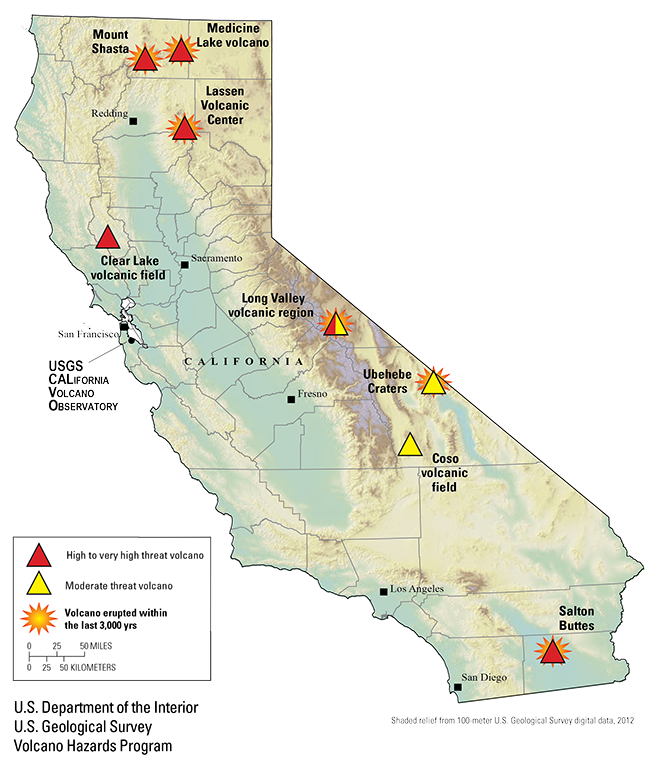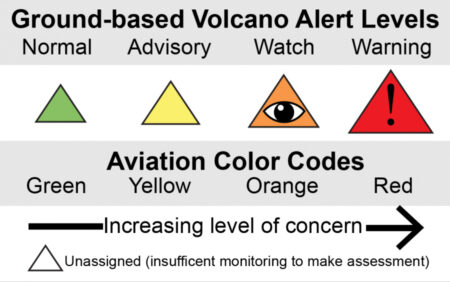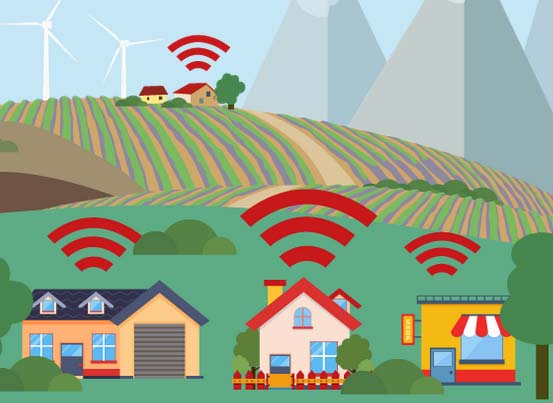Volcano Preparedness
In addition to fires, floods, earthquakes, and tsunamis, Californians are also subject to volcanic threats from the 8 volcanic areas classified as moderate, high, and very high threat in the state. These threat level classifications are defined and assigned in the USGS National Volcanic Threat Assessment released in 2018.
Volcanic eruptions in the state are not currently imminent. Using the threat levels, these volcanic areas are monitored continuously by Cal OES, for emergency management considerations and by the USGS California Volcano Observatory, for scientific observations of potential consequence. Almost all of the 8 significant volcanic areas are known for their local geothermal features, some of which produce energy for Californians.
The USGS has now released report 2018-5159 entitled California’s Exposure to Volcanic Hazards. Cal OES will use this important report along with the recently released National Volcanic Threat Assessment to initiate state level response planning.

About Volcanoes
Causes of Volcanic Eruptions
Volcanic eruptions and earthquakes are a way for Earth to release pressure and heat, much like a safety valve.
A volcano is basically a vent, or opening, in the earth’s crust from which hot molten rock, gases, and volcanic ash escape to the surface. They may erupt explosively like Krakatoa in 1883, or effusively seep out lava like the Kilauea volcano. Formed as a result of plate tectonics, volcanic eruptions can result in the formation of mountains, craters, crater lakes, plateaus, and islands.
Volcanoes are classified as active, dormant or extinct. An active volcano is the one that erupts or causes seismic activity on a regular basis over hundreds or thousands of years. A dormant volcano is one that has not erupted for a very long time, but could erupt again in the future. And, a volcano that has been dormant for more than 10,000 years is considered an extinct volcano.
See our “Tools and Resources” section below for more information.
Signs of Danger
- If you are near a volcano and watching for signs that it may erupt, here are some clues you might look for:
- An increase in seismic (earthquake) activity occurs prior to an impending eruption as the magma and gasses move below the surface. The magnitude of the earthquakes may be small.
- If you are looking at the cracks of a volcano’s surface, you may see vents (called fumaroles) that release pressure from the gasses below. If you see an increase in gases escaping from these vents, or a change in the temperature of the gases, this can signify a potential eruption.
- Scientists can determine if the magma has thickened. If so, it may trap gases under it which can lead to an eruption
- A sudden rise in the elevation of the ground and the appearance of new cracks may be a sign of an upcoming eruption.
- Changes in the groundwater temperature may occur prior to eruption.
Real Time Volcano Information
Scientists routinely monitor seismic activity near volcanoes which allows them to assess any unusual activity. They can also monitor gas, ground deformation and satellite imagery to determine if magma is rising toward the surface. This information can be assessed quickly and volcanic hazard information can be communicated as real-time warnings to prevent loss of life.
To sign up for email notifications, go the Unites States Geological Survey, Volcano Notification Service website. It only takes a minute and there is no cost.
Understanding the Volcano Alert Notification System
The U.S. Geological Survey (USGS) Volcano Hazards Program uses an alert-notification system to indicate the level of potential danger for volcanoes. Color-coded triangular signs are posted along with hazard details.

| Activation Color Code | Description |
| Normal/Green | The normal/green icon is used when background activity is within the range of typical non-eruptive phenomena seen at the volcano. |
| Advisory/Yellow | The advisory/yellow icon is used when a volcano is exhibiting signs of elevated activity above normal ranges. |
| Watch/Orange | The watch/orange icon is used when heightened or escalating unrest is exhibited with an increase in potential for eruption. In this stage the timeframe is unclear or an eruption is occurring posing limited hazard with no or minor emissions of volcanic ash. |
| Warning/Orange | The warning/orange icon is used when a major eruption is suspected, underway, or imminent, but no or minor volcanic ash emissions to impact aviation (lava flows only). |
| Watch/Red | The watch/red icon is used when an eruption occurs with limit hazard to ground based communities (little to no lava flow), but significant impacts to aviation with substantial emissions of ash in the atmosphere. |
| Warning/Red | The warning/red icon is used when a major a major eruption is suspected, underway, or imminent, with significant hazards expected to both ground based communities, and aviation. |
| Unassigned | The unassigned icon is used when ground-based instruments are unable to determine that a volcano is within normal parameters. |
Volcano Preparedness
Am I at Risk of a Volcanic Eruption?
Do you know if you live, work, shop, or play in an area at risk of volcanic eruption? To determine your risk, visit the United State Geological Survey Volcanoes and Current Activity map.
California is home to a variety of volcanoes, many of which most people are not aware. See a list of volcanoes in California.
For more information, visit your local emergency management website.
Prepare your Home and Family
Preparing your family for a possible volcanic eruption will not only help protect your health and property from volcanic ash and lava, but may be the difference between life and death. Preparing a plan of approach is vital, as is educating everyone in your family or household to better ensure their safety and wellbeing when a volcano erupts. Below are steps you can take to minimize impacts to your family and home in the event of volcanic eruption:
- Know where the active volcanoes are in your area and how close you are to them.
- Review your homeowner’s insurance policy, and if necessary, increase your level of coverage to ensure you are covered adequately.
- Obtain proper respiratory protection such as an air purifying respirator, also referred to as an N-95 disposable respirator. This can be found at your local hardware store.
- If there are disaster warning sirens in your area be aware of what they sound like. When a volcanic eruption occurs, you’ll want and need to listen for them.
- Create an emergency evacuation plan with your family. Review it often so that each person knows what to do, how to find each another if you’re apart, and how to contact neighbors and/or emergency services if you cannot get away from the property using your own transportation.
- Take into account anyone with functional and/or access needs, children, pets, and livestock.
- Know how to turn off all utilities.
- Create an emergency kit for your car including maps, tools, a first aid kit, a fire extinguisher, flares, additional non-perishable food, booster cables, sleeping bags and/or emergency blankets, and a flashlight.
There are many more ways to prepare your family. Please visit “Tools and Resources” below for further information.
Prepare your Workplace
According to the U.S. Bureau of Labor Statistics, American Time Use Survey, in 2013 the average work day for full time employed Americans (age 25-54 with children) was 8.7 hours. An eruption could occur anytime in that 8.7 hours. Are you prepared for that? Preparing your workplace is just as important as preparing your home. There are many ways to improve your safety in the event of a volcanic eruption. Here are just a few suggestions:
- Know if your workplace is in a location at risk of volcanic eruption.
- Be familiar with your company’s emergency plan.
- Know your local evacuation routes and evacuation sites.
- Keep a small bag of personal supplies (including walking shoes) that can be grabbed quickly and easily.
- Keep a list of emergency numbers handy.
- Listen to your radio for updates and an official “all clear” message before returning.
For more ideas and information visit the websites in “Tools and Resources” below.
Volcano Preparedness for Businesses and Organizations
Since volcanic eruptions can occur with little warning, it is important to be prepared. Developing a volcano preparedness plan is one of the most strategic decisions you can make if you are responsible for a business or organization. A workplace should follow accepted volcano safety guidelines, but have in place a personalized, well-rehearsed plan to help safeguard your organization during a volcanic eruption. Developing, and putting into place, a Disaster Plan will not only protect employees, but will help minimize the financial impact and help you recover more quickly from the disaster.
Many organizations play a role in assisting business owners with their disaster planning. The following websites can get you started preparing before the next disaster with sample plans, checklists, suggested educational programs for employees, exercise methods, and how to improve plans that are already in place.
Volcano Preparedness for Schools and Educators
While volcanic eruptions have occurred throughout history, our knowledge and understanding of preparing for them is much more recent. Through planning and education, we are now in a position to ensure the current and upcoming generations make volcano preparedness a regular part of their routine. As preparedness actions become the norm, students can take this information and teach their families and friends how to be prepared too.
As we learn more, our partners are applying that knowledge to assist teachers, parents and schools in the education of students of all ages and abilities by providing lesson plans, curriculum, activities, games, materials, publications and a multitude of other resources.
For easy access to resources for earthquake teaching resources, visit the “Tools and Resources” below.
Volcano Preparedness for Governments and Tribes
Cal OES Earthquake, Tsunami and Volcano Program staff are available to support California governmental agencies to increase the protection and safety of the populace in the event of a volcanic eruption. To this end, the Program staff are available to provide guidance and assistance to our partners in the preparation of plans to mitigate and plan for, respond to and recover from volcanoes impacting our State. In addition, see “Tools and Resources” below for developing the planning process.
Volcano Recovery
What to Do if an Eruption is Imminent
- Listen for advice and instructions from local officials
- Check your emergency kit that you prepared in advance and have it ready to go.
- Check that you have a full tank of gas and keep vehicles under cover until ready to leave (ash can prevent the engines from working).
- If you do not have transportation, make arrangements with other family members, neighbors or emergency personnel.
- Attend to the safety of pets and livestock if possible by enclosing them in a safe area or arranging for transportation to another location. If you take them with you, ensure you have food and water for them.
Preparing for ash fall
If instructed to evacuate:
1. Grab your emergency kit and ensure your car is ready.
2. Turn off the electricity and water in your home. Only turn off the gas if you suspect a leak or are instructed to do so. Gas can only be turned back on by a professional, which could take weeks.
3. Disconnect the appliances in your house.
4. Take the route designated by your local authorities and be prepared for delays.
5. Monitor television and radio stations for updates and further instructions.
6. Do not return to the impacted area until told to do so by the proper authorities.
If instructed to stay put (shelter in place):
1. Ensure you have an adequate supply of drinking water as local water supplies may become contaminated.
2. Gather extra water for cleanup. Use sinks, bathtubs and other containers as available.
3. Close and secure all windows and doors leading to the outside. If needed, seal with wet towels and/or duct tape.
4. Ensure all fans are off, including heaters and air conditioners and clothes dryers.
5. If you have one, ensure your fireplace damper is closed securely.
6. Move all pets or livestock inside. If not in the house, in a barn or garage. Ensure there is enough food and water.
7. Cover your car(s), machinery and electronics as ash may damage them. Do not uncover them until the environment is free of ash.
8. Shelter all family members in a room on the lowest floor without windows.
9. Listen to the television and/or radio for updates.
10. Do not open the house until given the “all clear” from proper authorities.
Preparing for lava flows
If your location is in the path of a lava flow, you must be ready to evacuate immediately when instructed to do so by local authorities. See evacuation procedures above.
What to Do when Returning Home
Whether you have sheltered in place or evacuated, entering an area covered in volcanic ash can be a risk to your health. If you must do so, there are ways to protect yourself. Here are just some of the recommended methods:
1. Wear safety goggles to protect your eyes, remove contact lenses as ash may get behind them and cause corneal abrasions.
2. Use a respirator to protect your lungs.
3. Cover all remaining parts of your body, including your hands, head and face.
4. When entering a building after walking through an ash covered area, remove your outer clothing to avoid spreading ash throughout the building.
5. Do not drive through ash if possible as it can clog the engine and cause abrasive damage to your car.
6. Keep children and animals away from ash. If pets get ash on their fur, hooves or paws, wash them immediately to avoid ingestion. Give them plenty of water for drinking.
Please see “Tools and Resources” below for further protective recommendations and safe removal of volcanic ash.
Local Exercises and Informational Events
Exercises and events will be posted as information becomes available.
Tools and Resources
Tools
- List of Volcanoes in California (USGS California Volcano Observatory)
- Volcanic Monitoring (USGS)
- Volcano Eruption Fact Sheet (multiple languages and large font) (Washington State Dept. of Health)
- Volcano Hazards Program Feeds (USGS)
- Volcano Frequently Asked Questions (USGS CalVO)
Informational Websites
- Learn about Volcanoes (USGS CalVO)
- Tribal Coordination (Cal OES)
- Planning and Preparedness (Cal OES)
- Volcanic Ash Facts and Guidance (USGS)
- Volcanoes: Earth’s Fiery Power (National Geographic)
For Schools and Educators
- School Planning and Preparedness (Cal OES)
- Virtual Volcano Field Trips (Oregon State University)
- Volcano Games (Oregon State University)
- Volcano Resources for Educators (USGS)
For Businesses and Organizations
- The Business and Industry Council for Emergency Planning and Preparedness (BICEPP)
- Emergency Management Guide for Business and Industry (FEMA)
- Emergency Preparedness Checklist for Small Businesses (FedEx)
- Ready.gov for Business (FEMA)
- U.S. Department of Homeland Security
- U.S. Small Business Administration (SBA)
Volcano Preparedness
- Volcano Safety Tips (ARC)
- Key Facts about Preparing for a Volcano Eruption (CDC)
- Key Facts about Protecting Yourself after a Volcanic Eruption (CDC)
- Prepare for a Volcanic Eruption (US EPA)
- Volcano Ready.gov (FEMA)
Volcano Recovery
- Recover After a Volcanic Eruption (US EPA)
Partners
Get emergency alerts
Wireless Emergency Alerts is a nation-wide system providing lifesaving information for the State of California

